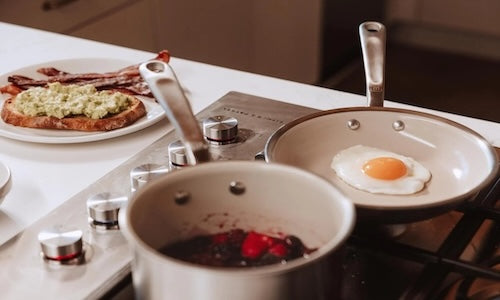Non-stick fry pans have become a must-have in modern kitchens. They make cooking and cleaning easier, require less oil, and help even beginners cook like pros. But questions about the coating’s safety — especially “Is Teflon toxic?” — still worry many home cooks.

In this guide, we’ll explain what non-stick pans are made of, how safe they are, the difference between Teflon (PTFE) and ceramic coatings, and how to use and maintain your pan safely.
What Is a Non-Stick Fry Pan?
A non-stick fry pan is typically coated with a material called polytetrafluoroethylene (PTFE), more commonly known by its brand name Teflon. This coating prevents food from sticking, making cooking easier and cleaning faster. A few drops of oil or butter are usually enough to cook your food perfectly.
Is the Non-Stick Coating Toxic?
The short answer: No — when used correctly, modern non-stick pans are safe.
Teflon coatings begin to break down only when heated above 500°F (260°C). At such extreme temperatures, the coating can release fumes that are harmful to birds or people exposed to high concentrations. However, under normal cooking conditions — frying eggs, pancakes, or vegetables — temperatures stay well below that level.
The main safety concern in the past came from a chemical called perfluorooctanoic acid (PFOA), once used in Teflon production. PFOA was linked to potential health risks, but since 2013 all major manufacturers have completely eliminated PFOA, following the U.S. Environmental Protection Agency (EPA) phase-out program.
So, modern Teflon and PTFE non-stick cookware sold today are PFOA-free and safe for everyday use.

How to Use Non-Stick Pans Safely
To get the best performance and safety from your non-stick pan:
-
Avoid preheating an empty pan.
Empty pans can reach very high temperatures quickly, causing coating degradation. -
Cook with medium or low heat.
There’s no need for high heat; non-stick pans conduct heat efficiently. -
Use wooden, silicone, or plastic utensils.
Metal spatulas or forks can scratch and damage the coating. -
Hand-wash gently.
Use soft sponges and mild dish soap instead of steel wool or abrasive pads. -
Replace old, scratched pans.
When the coating starts to peel or chip, it’s time for a new one — scratches can reduce performance and may trap burnt residues.

Types of Non-Stick Coatings
Modern non-stick pans generally fall into three categories:
1. PTFE (Teflon) Coating
-
Features: Smooth surface, excellent non-stick performance, and stable chemical properties.
-
Safety: Safe at normal cooking temperatures. Even if small flakes accidentally enter food, PTFE is inert and passes through the body without harm.
-
Maintenance: Avoid metal tools, extreme heat, or thermal shock. If the surface becomes rough or discolored, consider replacement.
2. Ceramic Coating
-
Features: Made by spraying a silica-based (sand-derived) gel onto metal and baking it to form a smooth, glass-like surface. Ceramic coatings can withstand up to 450°C (840°F) — higher than Teflon — and will not emit toxic fumes even if overheated.
-
Advantages: Attractive appearance, often colorful and stylish, good heat resistance.
-
Drawbacks: The non-stick performance fades faster than PTFE, and the coating is prone to scratches. Many users report food sticking after a few months of heavy use. Always choose lead- and cadmium-free certified brands to ensure safety.
3. Physical Non-Stick (No Coating)
-
Examples: Seasoned cast-iron or well-maintained stainless steel pans.
-
Principle: These pans become naturally non-stick when heated properly and seasoned with oil over time.
-
Advantages: No chemical coating, extremely durable, ideal for high-heat searing.
-
Drawbacks: Require maintenance (regular seasoning and drying), and beginners may find food sticking until they master the technique.

Popular Variants on the Market
You might have seen different marketing names for non-stick pans:
-
Marble or Granite Non-Stick Pan: These are still Teflon pans — the “stone pattern” is decorative.
-
Honeycomb Non-Stick Pan: These have a stainless-steel mesh etched over the Teflon layer, providing extra protection against scratches. They last longer but still rely on a PTFE base.
In essence, most so-called “innovative coatings” are just enhanced PTFE designs with improved durability or aesthetics.

Safe Alternatives to Traditional Non-Stick Cookware
If you prefer cookware with no coating at all, try these options:
-
Stainless Steel Pans: Excellent for browning and sautéing when preheated and oiled correctly. Dishwasher-safe and long-lasting.
-
Cast-Iron Skillets: Naturally non-stick after proper seasoning. Withstand very high temperatures and add a rustic flavor to your cooking.
-
Enameled Cast Iron or Clay Pots: Great for stews and soups, though heavier and more fragile.
When Should You Replace Your Non-Stick Pan?
If your non-stick pan shows deep scratches, peeling, or dull spots, it’s time to replace it. Using damaged cookware can lead to uneven heating and burnt food — even if it doesn’t pose toxicity risk, it affects both taste and quality.
Final Thoughts
Non-stick fry pans, whether Teflon or ceramic, are safe and convenient when used properly. The key lies in temperature control, gentle cleaning, and timely replacement. For those who enjoy traditional cookware, cast-iron or stainless steel remains an excellent natural alternative.
Where to Buy Reliable Cookware
At Chefco, we provide a full range of non-stick fry pans, stainless-steel cookware, cast-iron skillets, and ceramic-coated pots — all from trusted brands used by professional chefs and restaurants across Canada. Explore our Cookware to find safe, durable, and stylish pans for every kitchen.


